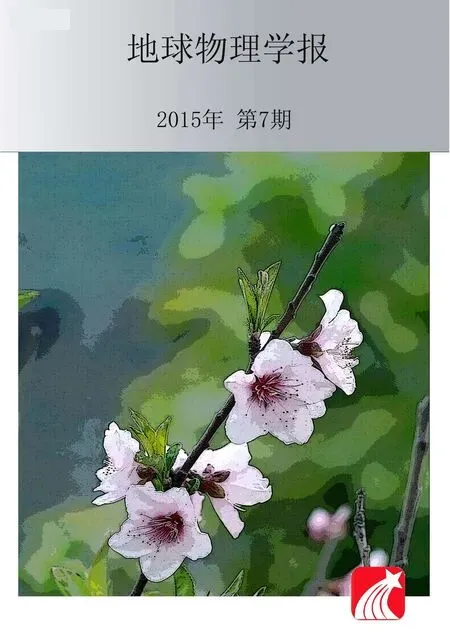川中古隆起超压分布与形成的地温场因素
刘一锋, 郑伦举, 邱楠生*, 贾京坤, 常青
1 中国石油大学(北京)油气资源与探测国家重点实验室, 北京 102249 2 中国石油大学(北京)盆地与油藏研究中心, 北京 102249 3 中国石化勘探开发研究院无锡石油地质研究所, 江苏无锡 214151
川中古隆起超压分布与形成的地温场因素
刘一锋1,2, 郑伦举3, 邱楠生1,2*, 贾京坤1,2, 常青1,2
1 中国石油大学(北京)油气资源与探测国家重点实验室, 北京 102249 2 中国石油大学(北京)盆地与油藏研究中心, 北京 102249 3 中国石化勘探开发研究院无锡石油地质研究所, 江苏无锡 214151
温度和压力是沉积盆地两个重要的物理场,温度影响着超压的形成和分布.本文根据钻孔实测温度和压力数据分析了川中古隆起现今压力与温度的关系;在实验室对封闭流体进行了多组温-压关系实验;利用等效镜质体反射率和包裹体测温数据恢复了川中古隆起不同井区在白垩纪抬升之前的最大古地温,并在此基础上分析了温度降低对研究区超压的影响;最后探讨了生烃增压和欠压实超压形成过程中温度的作用.研究结果表明,川中古隆起现今超压层的压力系数与温度呈正相关关系;在绝对密封的条件下,当压力大于15 MPa时,温度每变化1 ℃,压力变化1.076 MPa.川中地区不同井区自晚白垩世以来的差异性降温是现今同一超压层系超压强度不同的主要因素,此外超压层还应发生了流体的横向压力传递和泄漏.下古生界原油裂解形成超压的时间是180~110 Ma;气态烃伴生的盐水包裹体均一温度暗示了在90 Ma超压发生调整.盆地模拟结果显示温度对上三叠统须家河组的欠压实增压影响微弱.
川中古隆起; 温度; 超压; 物理模拟
1 引言
四川盆地在前震旦系基底形成以后,经历了复杂的构造—沉积演化历史,大致上可分为克拉通盆地阶段和前陆盆地阶段.克拉通盆地阶段以海相碳酸盐岩沉积为主,前陆盆地阶段则沉积了巨厚的陆相碎屑岩.多期构造运动造成现今盆地内发育多个不整合面和多套地层缺失,白垩纪以来的构造抬升运动使侏罗系及其以下地层出露地表(邓宾等,2009; Liu et al.,2012; 许海龙等,2012).川中古隆起位于四川盆地中部(图1),属于乐山—龙女寺鼻状构造的一部分.在加里东期该地区处于隆起部位,印支—燕山期为向北倾的斜坡,现今东部抬升较高,向西逐渐倾伏(王宓君等,1989; 许海龙等,2012).作为一个长期继承性发展的盆地内大型正向构造单元,川中古隆起具有广阔的油气勘探前景(姚建军等,2003; 魏国齐等,2010).目前已在震旦系、寒武系、三叠系和侏罗系发现多个商业油气藏.
前人对川中古隆起的现今地层压力状态已经做了大量研究,发现上三叠统至下寒武统多套地层都发育超压(杨金侠等,2003; Liu et al.,2008; 谢增业等,2009; 徐国盛等,2009; 郝国丽等,2010).钻井实测压力显示,古隆起上三叠统须家河组压力系数在1.0~2.0之间,平面上由西北向南逐渐降低(谢增业等,2009; 郝国丽等,2010).磨溪—龙女寺构造带下三叠统嘉陵江组压力系数大多在2.0以上(徐国盛等,2009).川中地区震旦系主要为常压—弱超压,而寒武系—奥陶系则表现为明显的超压,压力系数为1.0~1.82(Liu et al.,2008).盆地大地热流发生多期演化(邱楠生等,2008; Zhu et al.,2010; 王玮等,2011; 何丽娟等,2014),加之沉积层埋藏-抬升作用,使四川盆地地层温度经历了复杂且剧烈的变化过程.地温场对含油气盆地超压的形成和保存都有重要影响,但在我国相关研究开展较少.前人很早就发现温度升高可以引起孔隙流体压力增大(Barker,1972),但一些学者认为几乎不存在绝对封闭的盖层以及温度升高引起的流体体积膨胀量非常小,所以水热增压通常不是主要的超压机制(Luo and Vasseur,1992; Osborne and Swarbrick,1997).当含油气盆地发生构造抬升时(在此过程中泥岩欠压实、生烃作用、成岩作用等超压机制几乎全部停止),若异常压力还能长时间保存,即从侧面说明了封隔层的有效性,此时关于温度对地层压力的影响则不可忽略.如鄂尔多斯盆地,现今盆地内的异常低压就与构造抬升引起的温度降低密切相关(许浩等,2012; 李士祥等,2013).四川盆地自白垩纪以来发生了全盆范围的巨大抬升剥蚀,最大剥蚀量超过4000 m(邓宾等,2009; 朱传庆等,2009; Liu et al.,2012).温度降低对四川盆地超压的影响的相关研究目前尚属空白.本文利用钻孔温压数据厘清现今超压层的温度-压力关系;利用物理模拟方法探究温度对地层压力的控制;结合地层的温度演化史,探讨温度对川中古隆起超压的差异性分布和形成过程的影响.
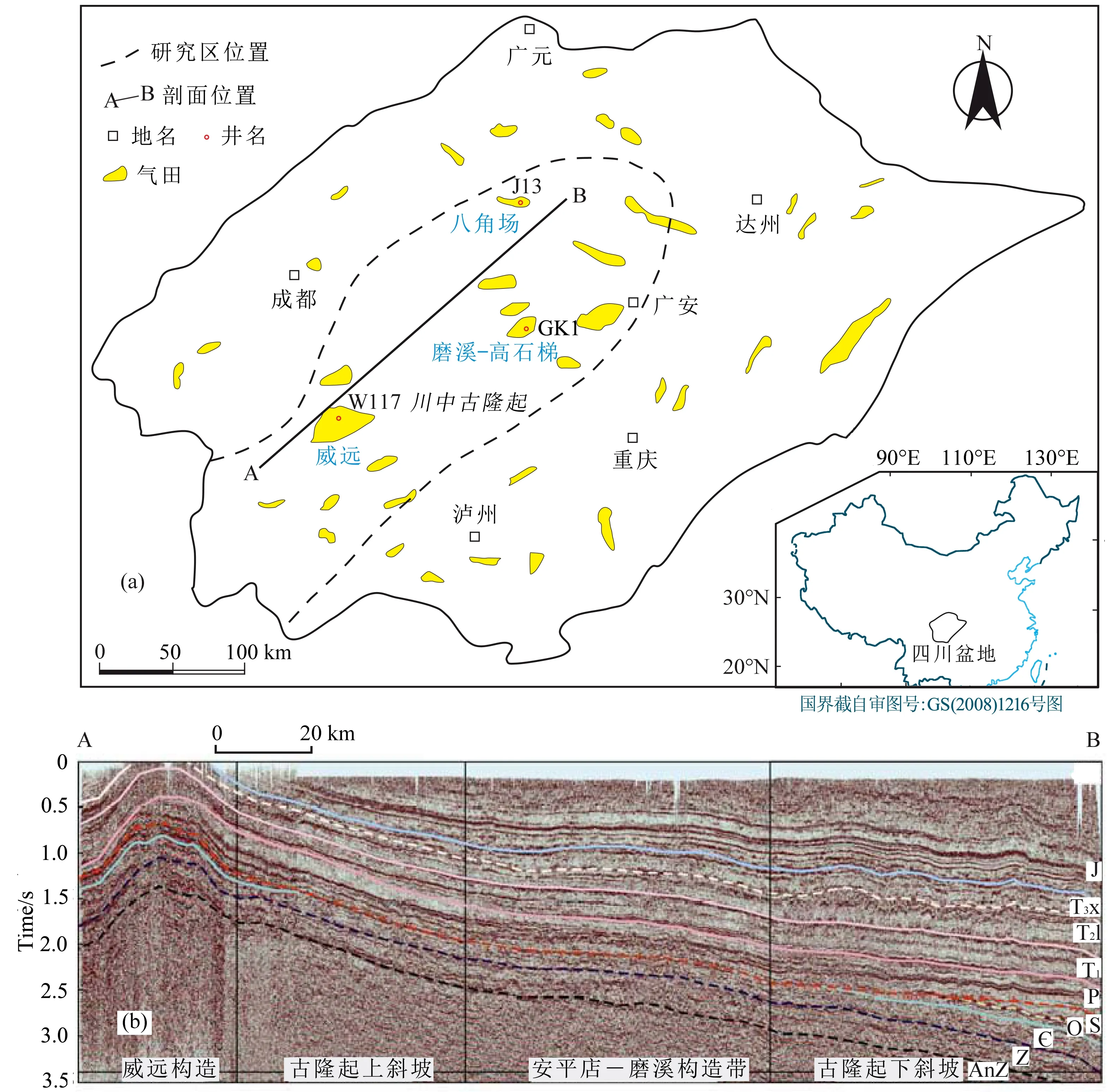
图1 (a) 四川盆地气田分布及剖面与研究井位置;(b) 研究区地震剖面(据许海龙等,2012)Fig.1 (a) Gas fields distribution and locations of the section and wells; (b) A seismic section in the study area(from Xu et al.,2012)
2 现今地层温度与压力
2.1 现今温度场特征
基于钻孔温度资料和大量的岩石热导率、生热率测量数据,关于盆地现今地温场的分布特征已经有了一定认识(谢晓黎和于汇津,1988; 韩永辉和吴春生,1993; 卢庆治等,2005; 徐明等,2011).四川盆地现今大地热流平均值为53.2 mW·m-2,低于我国大陆地区平均大地热流(63 mW·m-2),但比塔里木和准噶尔盆地的略高.四川盆地现今地温梯度为17.7~33.4 ℃/km.由于基底埋深较浅,川中和川南地区的大地热流(60~70 mW·m-2)和地温梯度(24~30 ℃/km)都明显高于川东北和川西北地区的(徐明等,2011).随着川中古隆起深层钻井数量增多,温度资料进一步丰富.本文收集了来自威远地区、磨溪—高石梯地区以及八角场地区代表钻井的试井温度(表1).寒武系龙王庙组和洗象池组以及上三叠统须家河组是川中地区主要的天然气产层,温度数据主要集中在上述层系.为了更好地反映温度分布特征,将各层系实测温度数据折算为该层系底界面温度.受埋深控制,同一套地层的温度差异较大,磨溪—高石梯地区寒武系底界面的温度为136~146.5 ℃,在威远地区寒武系底界面温度仅为95 ℃;磨溪—高石梯地区上三叠统须家河组底界面温度约为76.5~81.4 ℃,向西北方向温度逐渐升高,八角场地区须家河组的底界温度约为100 ℃.
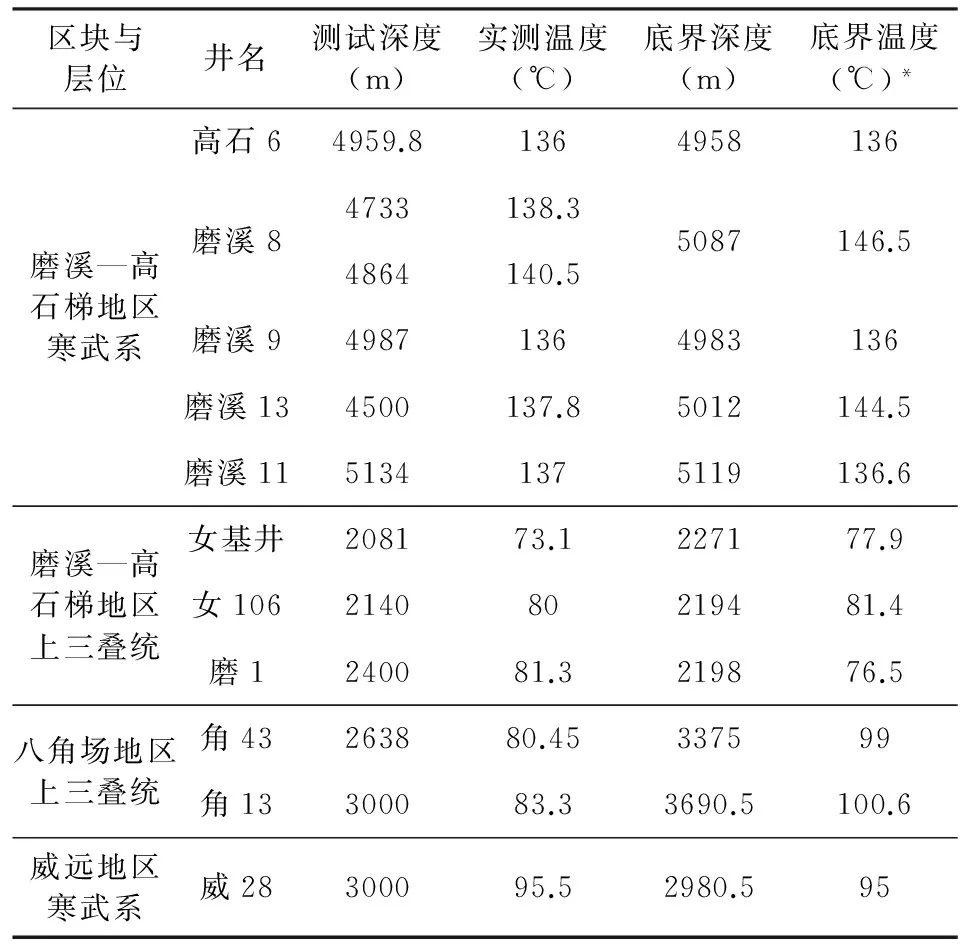
表1 川中古隆起不同地区代表井温度数据Table 1 Temperature data from bore holes in different position of the Central Paleo-Uplift in the Sichuan Basin
注:*底界温度折算时取地温梯度为2.5 ℃/km.
2.2 超压分布与超压成因
四川盆地是一个典型的超压盆地,不少学者都曾对盆地内超压分布和成因机制进行过探讨(王震亮等,2004; Liu et al.,2008; Tian et al.,2008; 郝国丽等,2010; 郭迎春等,2012).川中古隆起上三叠统须家河组、下三叠统嘉陵江组、下古生界寒武系和残留的奥陶系的地层压力都明显高于静水压力,其中嘉陵江组的压力系数接近2.0.上二叠统龙潭组泥岩虽无实际测压数据,但泥岩声波时差的明显异常也暗示了超高压的存在.笔者根据实测压力数据、钻井泥浆、声波测井等数据,结合流体特征和盖层分布,在磨溪—高石梯地区划分出多个超压系统(图2),超压发育深度大约在2000 m至5000 m;根据岩石物理性质,判断上三叠统须家河组和上二叠统超压主要为泥岩欠压实导致;下三叠统和下古生界(寒武系和残留的奥陶系)的超压主要与原油裂解生气导致的孔隙流体膨胀有关(图2).横向上,上三叠统须家河组在广安—铜梁一线的东南地区为正常压力,向西北方向超压逐渐增大,八角场地区须家河组压力系数达1.9(郝国丽等,2010);寒武系在威远地区表现为静水压力,在磨溪—高石梯地区压力系数达到了1.48~1.78(Liu et al.,2008).
2.3 现今地层压力与温度的关系
温度和压力作为盆地内两个重要的物理场,二者的耦合关系一直是学界关注的焦点.本文选取了温压测试数据较多的磨溪—高石梯地区、威远地区的寒武系和磨溪—高石梯地区、八角场地区的上三叠统须家河组两套超压层进行典型分析(图3).磨溪—高石梯地区寒武系平均地层温度为140 ℃,地层压力平均值为78.5 MPa;威远地区(威28井)寒武系温度为95 ℃,地层压力30.1 MPa.寒武系温-压斜率为1.075 MPa/℃.磨溪—高石梯地区须家河组平均地层温度为78.5 ℃,地层压力平均值为32.3 MPa.八角场地区须家河组平均地层温度为100 ℃,地层压力平均值为59 MPa.须家河组温-压斜率为1.24 MPa/℃.综上所述,川中地区寒武系和上三叠统须家河组地层压力及压力系数都与地层温度有着良好的正相关性,其中须家河组地层压力和压力系数随温度增加的增大幅度更大.
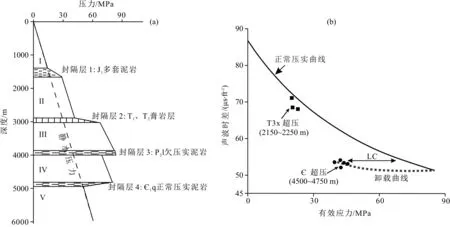
图2 (a) 磨溪—高石梯地区超压系统划分;(b) 寒武系与上三叠统须家河组超压机制判别: 须家河组超压由欠压实所致;寒武系超压由流体膨胀引起Fig.2 (a) Overpressure systems in the Moxi-Gaoshiti area; (b) Mechanisms for the Cambrian and Xujiahe overpressures: the Xujiahe Formation overpressure is caused by disequilibrium compaction and the Cambrian overpressure is mainly caused by fluid expansion

图3 川中古隆起寒武系龙王庙组底界面和三叠系须家河组底界面地层温压特征Fig.3 Temperature and pressure characteristics of the bottom of the Cambrian Longwangmiao formation and the Upper Triassic Xujiahe formation in the Central Paleo-Uplift of the Sichuan Basin
3 温度与压力的直接关系
良好的封闭条件是盆地内异常压力形成的前提.本文借助物理模拟实验探索封闭条件下温度与压力的关系.实验仪器如图4所示,“PVT釜”(容积约250 mL)能承受高温高压,恒温箱内的加热器可对“PVT釜”内的温度进行定量调节.实验中采用的恒压增压泵不仅将液体注入容器,还控制着“PVT釜”内的初始压力.搅拌器可以缩短系统的温压平衡时间.温度和压力感应计实时监测釜内温压变化,并通过电脑软件自动记录.为保证实验过程中测得的每组温压数据均为系统平衡后的真实温压状态,设置的温度变化速率缓慢(5 ℃/h).根据不同的初始温压条件,以胜利油田沙河街组地层水作为实验流体,共完成了4组物理模拟实验(图5).1、2组实验从高温高压状态逐渐降温;3、4组实验从低温低压状态逐渐升温.四组实验在温度改变至预计温度后都进行了逆向温度变化,使温度再次回到初始值.逆向变温过程中压力也沿着之前的变化路径逆向恢复至初始压力状态.
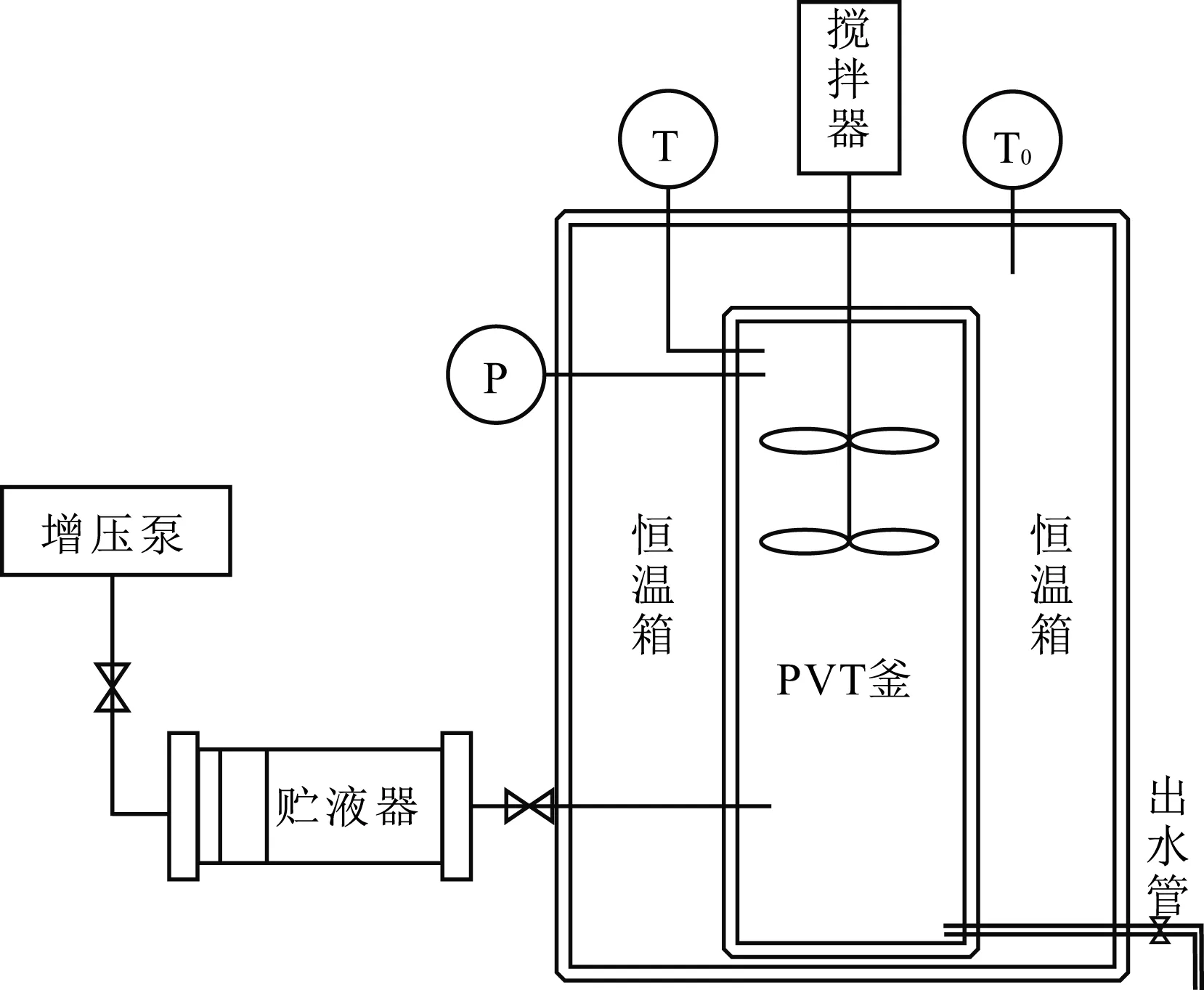
图4 温-压关系物理模拟实验仪器示意图 温度计T和T0分别监测“PVT釜”和 恒温箱的温度;压力计P测试釜内压力.Fig.4 Schematic diagram of the instrument for the temperature-pressure physical simulation experiment Temperatures in the “PVT Vessel” and the thermotank are monitored by thermometers T and T0; pressure in the “PVT Vessel” is monitored by the pressure meter (P).
实验结果表明,当压力大于15 MPa时,封闭系统内的温度-压力近乎为相互平行的直线关系,斜率为1.076 MPa/℃;当压力小于15 MPa时,压力随温度的变化幅度明显偏小(图5).这是由于在低温低压时水的热膨胀系数较小.从图5中还可以看出在绝对封闭的条件下,埋深-抬升过程中温度改变造成的压力变化幅度远大于相同深度变化时静水压力的变化;温度变化引起的地层压力变化幅度略小于同等埋深变化时静岩压力的改变量.
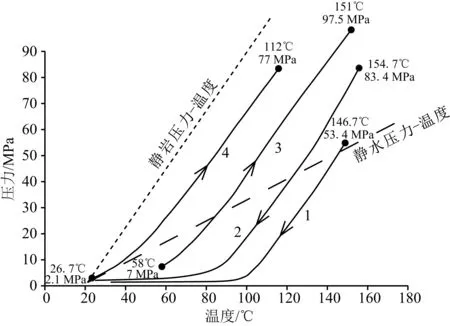
图5 温-压关系物理模拟实验结果 两条虚线分别代表盆地内静岩压力和静水压力与温度的关系线(假设地表温度为20 ℃,地温梯度为3 ℃/100m);圆点处的 温度和压力值代表实验端点的温度和压力.Fig.5 Results of the temperature-pressure relationship physic simulation experiment Two dashed lines represent temperature-lithostatic pressure and temperature-hydrostatic pressure relations respectively.
4 温度对川中古隆起超压的影响
4.1 晚期降温对超压的影响
根据盆地沉积演化历史分析,各地层在晚白垩世抬升前达到其所经历的最大古地温.等效镜质体反射率(Requ)作为有机质成熟度指标是目前国内外盆地热史研究中最常见和最成熟的古温标参数(邱楠生等,2004).Requ用于恢复古地温的最大优势是可以反映地层在地质历史中所经历的最高温度.图6为川中古隆起不同井区的3口典型井的Requ剖面.如图所示八角场地区地层埋深最大;威远地区地层埋深较浅,寒武系埋深小于3000 m;磨溪—高石梯地区地层埋深处于八角场和威远地区之间.川中地区不同构造位置的埋深差异主要与晚白垩世以来的差异性抬升剥蚀有关.现今川中地区中、古生界的Requ值分布在0.99%~3.25%之间.
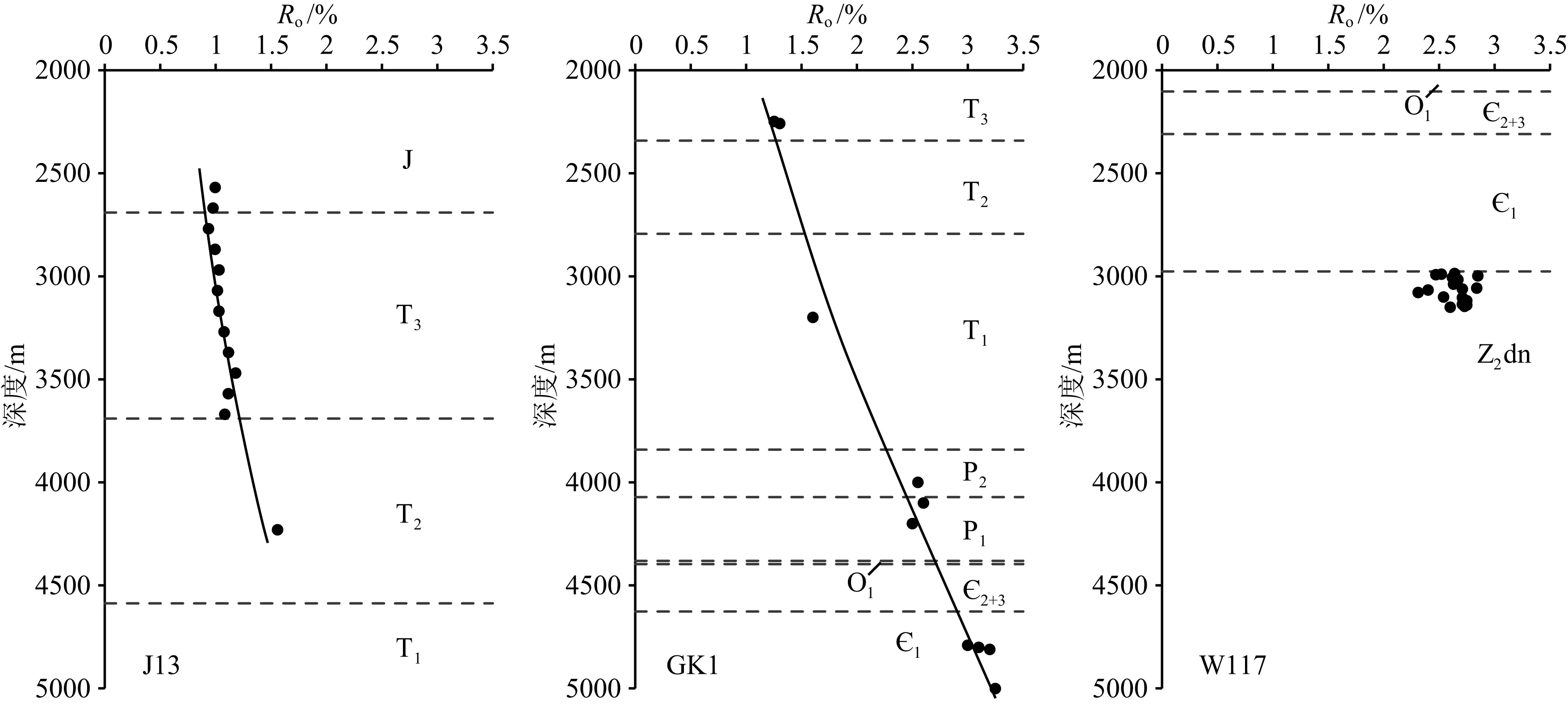
图6 川中古隆起典型单井Ro剖面(井位见图1)Fig.6 Ro vs. depth plot for three wells in the Central Paleo-Uplift of the Sichuan Basin (wells location are shown in Fig.1)
本文在利用Requ计算最大古地温时采用平行化学反应模型(Easy%Ro),计算结果见表2.磨溪—高石梯地区三叠系和寒武系的最大古地温分别略高于八角场地区三叠系的最大古地温和威远地区寒武系的最大古地温.对比现今地温,可得到白垩纪构造抬升所造成的温度减小量;再结合物理模拟结果,即可计算温度降低对超压层压力降低的贡献(表2).降温幅度差异使得八角场地区须家河组的压力减小量小于磨溪—高石梯地区须家河组的压力减小量,二者相差33.4 MPa;磨溪—高石梯地区寒武系的压力减小量小于威远地区寒武系的压力减小量,二者相差30.1 MPa.因此,温度降低是川中古隆起现今各超压层系在不同井区压力系数存在差异的主要原因.
此外,注意到八角场地区与磨溪—高石梯地区须家河组由温度降低造成的压力差(33.4 MPa)大于现今实际压力差(约27 MPa),而威远地区与磨溪—高石梯地区寒武系由温度降低造成的压力差(30.1 MPa)小于现今实际压力差(约48 MPa).由于抬升前埋深基本相同(同一套地层的最大古地温差异较小,见表2),可以认为川中地区在抬升前同一套地层的压力状态基本一致,从而排除抬升前就存在压力差异的原因.须家河组实际压力差偏小,说明在碎屑岩层系内发生了流体横向运移、压力横向传递.寒武系实际压差偏大,可能是由于威远隆起区大幅抬升后保存条件比磨溪—高石梯地区寒武系的保存条件差,发生了流体的部分泄漏,现今地层压力已降低为静水压力.
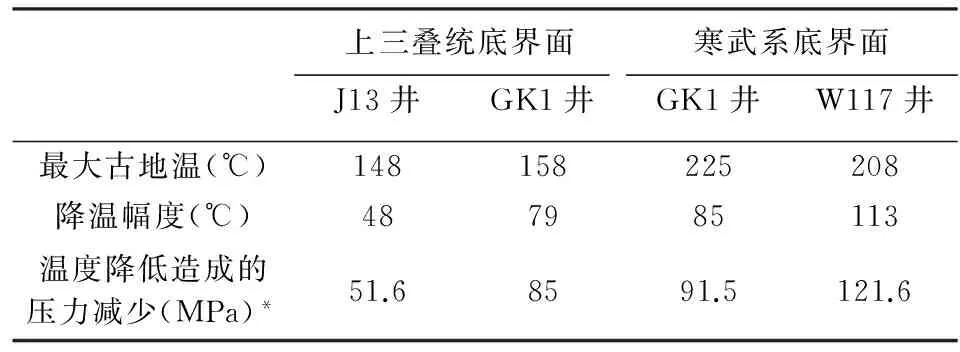
表2 川中古隆起不同井区T3、∈温度降低量 及其引起的压力下降幅度Table 2 Temperature reduction and the corresponding pressure decrease for T3 and ∈ in different wells in the Central Paleo-Uplift of the Sichuan Basin
注:*温度降低造成的压力减小=降温幅度×1.076 MPa/℃.
4.2 温度对生烃增压的控制

泥岩欠压实在盆地超压形成中具有重要意义.泥岩欠压实(也称不均衡压实)形成异常高压的根本原理是快速埋藏使泥岩孔隙快速减小,流体排出受滞并承担了部分骨架压力,从而形成超压.欠压实形成的超压随着埋深增大而增大,在埋深最大时超压也达到最大.地下流体流动满足达西定律:
(1)
其中
ρ=ρsc·exp[β(P-0.1)-α(T-25)],
(2)
μ=10n;
(3)
式中v为流体流速, m/s;K为渗透率, m2;μ为黏度, MPa·s; dh/dl为压力差, MPa;ρ、ρsc分别为地下和地表时水的密度, kg·m-3;T为温度, ℃;α=5×10-4℃-1,β=4.3×10-4MPa-1.公式(2)据(Bethke,1985).
根据式(2)和式(3)可以看出,温度升高会造成地层水密度和黏度的减小,但黏度的减小幅度更加显著;进而在渗透率和压差都不变的情况下,造成流速的增大(式(1)).因此,温度升高在欠压实形成过程中起到负面的作用.但是,在欠压实形成时渗透率快速降低至极小值,并成为影响流速和超压形成的最关键因素.相比而言,温度引起的密度和黏度变化对流体流速及超压的影响可以忽略不计.本文通过盆地模拟结果也证明,即使川中古隆起上三叠统的温度改变50 ℃,欠压实超压的变化也非常有限(超压改变量小于1%).
5 讨论
5.1 沉积盆地现今温-压关系
沉积盆地现今温度-压力关系是漫长地质历史过程中多种作用的结果,分析现今温度-压力关系应深入考虑其所处的盆地环境和演化历程.若把地下温度和压力作为一个整体并认为盆地是由一个个“封闭系统”组成,则每一个封闭系统内温度与压力应保持线性关系(刘震等,2012):
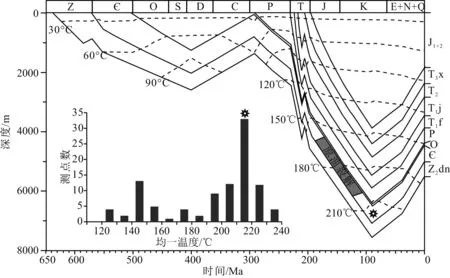
图7 GK1井埋藏史、原油裂解时间与磨溪—高石梯地区下古生界烃类伴生盐水包裹体均一温度Fig.7 Burial history and the time of oil cracking for Well GK1 and the homogenization temperature of aqueous inclusionswhich associated with hydrocarbon inclusions from the Lower Paleozoic in the Moxi-Gaoshiti area

(4)
式中P为压力,MPa;T为温度,℃;K为斜率,MPa/℃;L为常数.进而得到系统内的温-压斜率为

(5)
式中ΔP为压力梯度,MPa/100 m;ΔT为地温梯度, ℃/100 m.
对于浅部静水压力系统,由于ΔP基本保持在1 MPa/100 m左右,系统内温-压斜率K主要受地温梯度的影响.不同沉积盆地的平均地温梯度差异很大(1.5 ℃/100 m~4.5 ℃/100 m),对K产生的影响明显.我国东部盆地地温梯度(>3.5 ℃/100 m)明显高于中西部盆地(<2.5 ℃/100 m),因此,东部盆地的浅层温-压斜率整体上应大于中西部盆地.对于深部有异常压力发育的系统,压力梯度(0.8 MPa/100 m~2.2 MPa/100 m)和地温梯度一起控制着现今温-压斜率.现今压力梯度是地质历史复杂作用的结果,现今地温梯度则是目前盆地热背景的响应.
5.2 构造抬升时其他作用对压力的影响
构造抬升引起上覆静岩压力减小,地层可能会产生弹性或非弹性形变.姜振学等(2007)通过物理模拟实验显示,天然砂岩的体积回弹量通常小于1%,且其中80%的回弹量都是集中在5~0 MPa的低压阶段.构造抬升可能会发生褶皱和裂缝等非弹性形变.川中古隆起远离盆地边缘,喜山期以整体抬升为主,发生褶皱变形不明显.裂缝和断裂对超压体系的封闭能力会造成极大破坏,流体泄漏之后超压也随之消失.四川盆地发育的多套优质盖层(见图2左)在抬升剥蚀过程中没有被破坏,是现今川中地区超压以及气藏得以保存的关键.裂缝产生的孔隙很小,即使在裂缝发育地层,裂缝孔隙度主要为0.01%~0.04%(昌伦杰等,2014),对超压的影响有限.但裂缝会显著提高地层的渗透率,超压流体在超压系统内部流动速率及压力传递效率提高.综上所述,以碳酸盐岩和致密砂岩为主的四川盆地,构造抬升造成的地层形变对现今仍旧埋藏较深的超压系统的影响不是最主要的.
当孔隙流体为烃类(特别是气态烃)时,其热膨胀系数与地层水明显不同,会改变图5所示的温-压变化关系,甚至形成超压(Katahara and Corrigan,2002).但是由于地层水是地层孔隙的主要流体(即便是川中古隆起须家河组天然气产层的含水饱和度也在45%~96%(曾青高等,2009)),因此当温度降低时,四川盆地的孔隙压力仍旧是逐渐减小.
6 结论
依据对川中古隆起温压场的上述分析,可以得出如下结论:
(1)川中古隆起现今发育多个超压系统.同一超压层系在不同井区的压力不同,例如威远地区寒武系为常压,磨溪—高石梯地区寒武系为超压;磨溪—高石梯地区须家河组压力系数小于八角场地区须家河组的压力系数.结合现今地温场的分布特征,发现同一超压层系的压力值和超压强度与温度呈正相关性.
(2)物理模拟实验结果显示,在绝对封闭条件下流体压力随温度改变而改变.当压力大于15 MPa时,温度-压力关系近乎为线性关系(1.076 MPa/℃).分析川中古隆起温度演化历史,认为白垩纪以来差异性降温是现今各井区超压差异的关键.此外,现今压力分布格局还应叠加了压力横向传递及流体散失的影响.
(3)温度是川中古隆起生烃增压的“外因”,根据古温度恢复结果,结合包裹体测温数据,确定寒武系超压形成于180~110 Ma,在构造抬升前(~90 Ma)发生压力调整.温度对于上三叠统须家河组的欠压实超压形成的影响可以忽略不计.
Barker C. 1972.Aquathermal pressuring-role of temperature in development of abnormal-pressure zones.AAPGBulletin, 56(10): 2068-2071.
Bethke C M. 1985. A numerical model of compaction-driven groundwater flow and heat transfer and its application to the paleohydrology of intracratonic sedimentary basins.JournalofGeophysicalResearch:SolidEarth, 90(B8): 6817-6828.
Chang L J, Zhao L B, Yang X J, et al. 2014. Application of industrial computed tomography (ICT) to research of fractured tight sandstone gas reservoirs.XinjiangPetroleumGeology(in Chinese), 35(4): 471-475.
Deng B, Liu S G, Liu S, et al. 2009. Restoration of exhumation thickness and its significance in Sichuan Basin, China.JournalofChengduUniversityofTechnology(Science&TechnologyEdition) (in Chinese), 36(6): 675-686.
Guo Y C, Pang X Q, Chen D X, et al. 2012. Evolution of continental formation pressure in the middle part of the Western Sichuan Depression and its significance for hydrocarbon accumulation.PetroleumExplorationandDevelopment(in Chinese), 39(4): 426-433.
Han Y H, Wu C S. 1993.Geothermal gradient and heat flow values of some deep wells in Sichuan Basin.OilandGasGeology(in Chinese), 14(1): 80-84.
Hao F, Guo T L, Zhu Y M, et al. 2008.Evidence for multiple stages of oil cracking and thermochemical sulfate reduction in the Puguang gas field, Sichuan Basin, China.AAPGBulletin, 92(5): 611-637.
Hao G L, Liu G D, XieZ Y, et al. 2010.Distribution and origin of abnormal pressure in Upper Triassic Xujiahe Formation reservoir in central and southern Sichuan.GlobalGeology(in Chinese), 29(2): 298-304.
He L J, Xu H H, Wang J Y. 2011. Thermal evolution and dynamic mechanism of the Sichuan Basin during the Early Permian-Middle Triassic.ScienceChina:EarthSciences, 54(12): 1948-1954.
He L J, Huang F, Liu Q Y, et al. 2014. Tectono-thermal evolution of Sichuan Basin in Early Paleozoic.JournalofEarthSciencesandEnvironment(in Chinese), 36(2): 10-17.
Huang F, Liu Q Y, He L J. 2012. Tectono-thermal modeling of the Sichuan Basin since the Late Himalayan Period.ChineseJournalofGeophysics(in Chinese), 55(11): 3742-3753,doi: 10.6038/j.issn.0001-5733.2012.11.021.
Jiang Z X, Tian F H, Xia S H. 2007. Physical simulation experiments of sandstone rebounding.ActaGeologicaSinica(in Chinese), 81(2): 244-249.
Katahara K W, Corrigan J D.2002. Effect of gas on poroelastic response to burial or erosion.∥Huffman A R, Bowers G L, eds. Pressure Regimesin Sedimentary Basins and their Prediction.AAPG Memoir 76, 73-78.
Li S X, Shi Z J, Liu X Y,et al. 2013. Quantitative analysis of the Mesozoic abnormal low pressure in Ordos Basin.PetroleumExplorationandDevelopment(in Chinese), 40(5): 528-533. Liu Z, Zhu W Q, Sun Q, et al. 2012. Characteristics of geotemperature-geopressure systems in petroliferous basins of China.ActaPetroleiSinica(in Chinese), 33(1): 1-17.
Liu S G, Wang H, Sun W, et al. 2008. Energy field adjustment and hydrocarbon phase evolution in Sinian-Lower Paleozoic Sichuan Basin.JournalofChinaUniversityofGeosciences, 19(6): 700-706.
Liu S G, Deng B, Li Z W, et al. 2012.Architecture of basin-mountain systems and their influences on gas distribution: A case study from the Sichuan basin, South China.JournalofAsianEarthSciences, 47(2): 204-215.
Lu Q Z, Hu S B, GuoT L, et al. 2005. The background of the geothermal field for formation of abnormal high pressure in the northeastern Sichuan basin.ChineseJournalofGeophysics(in Chinese), 48(5): 1110-1116, doi:10.3321/j.issn:0001-5733.2005.05.019.
Luo X R, Vasseur G. 1992. Contributions of compaction and aquathermal pressuring to geopressure and the influence of environmental conditions.AAPGBulletin, 76(10): 1550-1559.
Osborne M J, Swarbrick R E. 1997.Mechanisms for generating overpressure in sedimentary basins: a reevaluation.AAPGBulletin, 81(6): 1023-1041.
Qiu N S, Hu S B, He L J. 2004. Theory and Application of Thermal Regime Study in Sedimentary Basins (in Chinese). Beijing: Petroleum Industry Press,240.
Qiu N S, Qin J Z, McInnes B I A, et al. 2008.Tectonothermal evolution of the Northeastern Sichuan Basin: Constraints from apatite and zircon (U-Th)/He ages and vitrinite reflectance data.GeologicalJournalofChinaUniversities(in Chinese), 14(2): 223-230.
Tian H, Xiao X M, Wilkins R W T, et al. 2008.New insights into the volume and pressure changes during the thermal cracking of oil to gas in reservoirs: Implications for the in-situ accumulation of gas cracked from oils.AAPGBulletin, 92(2): 181-200.
Tian Y T, Zhu C Q, Xu M, et al. 2011. Post-Early Cretaceous denudation history of the northeastern Sichuan Basin: constraints from low-temperature thermochronology profiles.ChineseJournalofGeophysics(in Chinese), 54(3): 807-816, doi:10.3969/j.issn.0001-5733.2011.03.021.
Wang M J, Bao C, Li M J. 1989. Petroleum geology of Sichuan Basin (in Chinese).∥ZhaiG M ed. Petroleum Geology of China, Volume 10. Beijing: Petroleum Industry Press, 516.
Wang W, Zhou Z Y, Guo T L, et al. 2011. Early Cretaceous-paleocene Geothermal Gradients and Cenozoic Tectono-thermal History of Sichuan Basin.JournalofTongjiUniversity(Natural Science) (in Chinese), 39(4): 606-613.
Wang Z L, Sun M L, Zhang L K, et al. 2004. Evolution of abnormal pressure and model of gas accumulation in Xujiahe Formation, western Sichuan Basin.EarthScience-JournalofChinaUniversityofGeosciences(in Chinese), 29(4): 433-439.
Waples D W. 2000. The kinetics of in-reservoir oil destruction and gas formation: constraints from experimental and empirical data, and from thermodynamics.OrganicGeochemistry, 31(6): 553-575.
Wei G Q, Jiao G H, Yang W, et al. 2010.Hydrocarbon pooling conditions and exploration potential of Sinian-Lower Paleozoic gas reservoirs in the Sichuan Basin.NaturalGasIndustry(in Chinese), 30(12): 5-9.
Xie X L, Yu H J. 1988. The characteristics of the regional geothermal field in Sichuan Basin.JournalofChengduCollegeofGeology(in Chinese), 15(4): 110-117.
Xie Z Y, Yang W, Gao J Y, et al. 2009. The characteristics of fluid inclusion of Xujiahe Formation reservoirs in central-south Sichuan Basin and its pool-forming significance.BulletinofMineralogy,PetrologyandGeochemistry(in Chinese), 28(1): 48-52.
Xu G S, Meng Y Z, Zhao Y H, et al. 2009.The study of accumulation mechanism of natural gas in Jialingjiang Formation, Moxi-Longnüsi area in the middle of Sichuan Basin.PetroleumGeology&Experiment(in Chinese), 31(6): 576-582.
Xu H L, Wei G Q, Jia C Z, et al. 2012. Tectonic evolution of the Leshan-Longnüsipaleo-uplift and its control on gas accumulation in the Sinian strata, Sichuan Basin.PetroleumExplorationandDevelopment(in Chinese), 39(4): 406-416.
Xu H, Zhang J F, Tang D Z, et al. 2012. Controlling factors of underpressure reservoirs in the Sulige gas field, Ordos Basin.PetroleumExplorationandDevelopment(in Chinese), 39(1): 64-68.
Xu M, Zhu C Q, Tian Y T, et al. 2011. Borehole temperature logging and characteristics of subsurface temperature in the Sichuan Basin.ChineseJournalofGeophysics(in Chinese), 54(4): 1052-1060, doi:10.3969/j.issn.0001-5733.2011.04.020.
Yang J X, Gao S L, Wang Z L. 2003. Pore pressure characteristics and petroleum migration in the Upper Triassic Formation in the central-southern of the Sichuan Basin.GasExplorationandDevelopment(in Chinese), 26(2): 6-11.
Yao J J, Chen M J, Hua A G, et al. 2003.Formation of the gas reservoirs of the Leshan-Longnvsi Sinianpaleo-uplift in central Sichuan.PetroleumExplorationandDevelopment(in Chinese), 30(4): 7-9.Zeng Q G, Gong C M, Li J L, et al. 2009. Exploration achievements and potential analysis of gas reservoirs in the Xujiahe formation, central Sichuan Basin.NaturalGasIndustry(in Chinese), 29(6): 13-18.Zhu C Q, Xu M, Shan J N, et al. 2009. Quantifying the denudations of major tectonic events in Sichuan basin: Constrained by the paleothermal records.GeologyinChina(in Chinese), 36(6): 1268-1277.
Zhu C Q, Xu M, Yuan Y S, et al. 2010.Palaeogeothermal response and record of the effusing of Emeishan basalts in the Sichuan basin.ChineseScienceBulletin, 55(10): 949-956.
附中文参考文献
昌伦杰, 赵力彬, 杨学君等. 2014. 应用 ICT 技术研究致密砂岩气藏储集层裂缝特征. 新疆石油地质, 35(4): 471-475.
邓宾, 刘树根, 刘顺等. 2009. 四川盆地地表剥蚀量恢复及其意义. 成都理工大学学报(自然科学版), 36(6): 675-686.
郭迎春, 庞雄奇, 陈冬霞等. 2012. 川西坳陷中段陆相地层压力演化及其成藏意义. 石油勘探与开发, 39(4): 426-433.
韩永辉, 吴春生. 1993. 四川盆地地温梯度及几个深井的热流值. 石油与天然气地质, 14(1): 80-84.
郝国丽, 柳广弟, 谢增业等. 2010. 川中—川南地区上三叠统须家河组气藏异常压力分布及成因. 世界地质, 29(2): 298-304.
何丽娟, 黄方, 刘琼颖等. 2014. 四川盆地早古生代构造—热演化特征. 地球科学与环境学报, 36(2): 10-17.
黄方, 刘琼颖, 何丽娟. 2012. 晚喜山期以来四川盆地构造—热演化模拟. 地球物理学报, 55(11): 3742-3753, doi: 10.6038/j.issn.0001-5733.2012.11.021.
姜振学, 田丰华, 夏淑华. 2007. 砂岩回弹物理模拟实验. 地质学报, 81(2): 244-249.
李士祥, 施泽进, 刘显阳等. 2013. 鄂尔多斯盆地中生界异常低压成因定量分析. 石油勘探与开发, 40(5): 528-533.
刘震, 朱文奇, 孙强等. 2012. 中国含油气盆地地温—地压系统. 石油学报, 33(1): 1-17.
卢庆治, 胡圣标, 郭彤楼等. 2005. 川东北地区异常高压形成的地温场背景. 地球物理学报, 48(5): 1110-1116, doi:10.3321/j.issn:0001-5733.2005.05.019.
邱楠生, 胡圣标, 何丽娟. 2004. 沉积盆地热体制研究的理论与应用. 北京: 石油工业出版社, 240.
邱楠生, 秦建中, McInnes B I A等. 2008. 川东北地区构造—热演化探讨——来自(U-Th)/He年龄和Ro的约束. 高校地质学报, 14(2): 223-230.
田云涛, 朱传庆, 徐明等. 2011. 晚白垩世以来川东北地区的剥蚀历史——多类低温热年代学数据综合剖面的制约. 地球物理学报, 54(3): 807-816, doi:10.3969/j.issn.0001-5733.2011.03.021.
王宓君, 包茨, 李懋钧. 1989. 四川石油志. ∥翟光明. 中国石油地质志: 卷十. 北京: 石油工业出版社, 516.
王玮, 周祖翼, 郭彤楼等. 2011. 四川盆地古地温梯度和中-新生代构造热历史. 同济大学学报(自然科学版), 39(4): 606-613.
王震亮, 孙明亮, 张立宽等. 2004. 川西地区须家河组异常压力演化与天然气成藏模式. 地球科学—中国地质大学学报, 29(4): 433-439.
魏国齐, 焦贵浩, 杨威等. 2010. 四川盆地震旦系-下古生界天然气成藏条件与勘探前景. 天然气工业, 30(12): 5-9.
谢晓黎, 于汇津. 1988. 四川盆地区域地温场的特征. 成都地质学院学报, 15(4): 110-117.
谢增业, 杨威, 高嘉玉等. 2009. 川中—川南地区须家河组流体包裹体特征及其成藏指示意义. 矿物岩石地球化学通报, 28(1): 48-52.
徐国盛, 孟昱璋, 赵异华等. 2009. 川中磨溪—龙女寺构造带嘉陵江组天然气成藏机理研究. 石油实验地质, 31(6): 576-582.
许海龙, 魏国齐, 贾承造等. 2012. 乐山—龙女寺古隆起构造演化及对震旦系成藏的控制. 石油勘探与开发, 39(4): 406-416.
许浩, 张君峰, 汤达祯等. 2012. 鄂尔多斯盆地苏里格气田低压形成的控制因素. 石油勘探与开发, 39(1): 64-68.
徐明, 朱传庆, 田云涛等. 2011. 四川盆地钻孔温度测量及现今地热特征. 地球物理学报, 54(4): 1052-1060, doi:10.3969/j.issn.0001-5733.2011.04.020.
杨金侠, 高胜利, 王震亮. 2003. 四川盆地中西部上三叠统地层压力特征与油气运聚. 天然气勘探与开发, 26(2): 6-11.
姚建军, 陈孟晋, 华爱刚等. 2003. 川中乐山—龙女寺古隆起震旦系天然气成藏条件分析. 石油勘探与开发, 30(4): 7-9.
曾青高, 龚昌明, 李俊良等. 2009. 川中地区须家河组气藏勘探成果及潜力分析. 天然气工业, 29(6): 13-18.
朱传庆, 徐明, 单竞男等. 2009. 利用古温标恢复四川盆地主要构造运动时期的剥蚀量. 中国地质, 36(6): 1268-1277.
(本文编辑 胡素芳)
The effect of temperature on the overpressure distribution and formation in the Central Paleo-Uplift of the Sichuan Basin
LIU Yi-Feng1,2, ZHENG Lun-Ju3, QIU Nan-Sheng1,2*, JIA Jing-Kun1,2, CHANG Qing1,2
1StateKeyLaboratoryofPetroleumResourceandProspecting,ChinaUniversityofPetroleum,Beijing102249,China2ResearchCenterforBasinandReservoir,ChinaUniversityofPetroleum,Beijing102249,China3WuxiResearchInstituteofPetroleumGeology,SINOPEC,WuxiJiangsu214151,China
Temperature and pore pressure are two important physical fields in sedimentary basins. Some potential mechanisms of overpressure, such as aquathermal expansion, diagenesis and hydrocarbon generation, are related to temperature. Furthermore, temperature may control evolution and distribution characteristics of overpressure. The Sichuan Basin, located in southwest China, is a typical overpressuring basin. Combining physical simulation results with practical geological condition, the impact of temperature on overpressures in the Central Paleo-Uplift of the Sichuan Basin is analyzed.The measured temperature and pore pressure data, which were obtained from boreholes in different gas fields, were collected to analyze the present relationship between temperature and pressure. Physical simulation experiments were carried out in laboratory to study the temperature-pressure relationship in absolutely sealed condition. The Easy%Romodel for vitrinite reflectance and micro-thermometry of fluid inclusions were applied to reconstruct the maximum paleo-temperatures of various formations for different regions in the Central Paleo-Uplift. Based on the thermal history, the impacts of temperature on overpressures generation through oil cracking and disequilibrium compaction were discussed.Multiple overpressure systems exist vertically in the Central Paleo-Uplift in the Sichuan Basin and the main mechanisms for each overpressure system are different. According to petrophysical properties of overpressuring formations, the Upper Triassic overpressure is mainly generated by disequilibrium compaction and the Cambrian overpressure is mainly caused by gas generation, respectively. For the same overpressuring formation, overpressure is positively correlated with temperature in the lateral direction. The pressure-temperature gradient is 1.075 MPa/℃ for the Cambrian overpressure system and 1.24 MPa/℃ for the Upper Triassic overpressure system. Physical simulation experiment results show that fluid pressure is closely related to temperature in absolutely sealed condition. The pressure-temperature gradient is relatively small in low pressure phase and such relationship is almost linear as pressure is higher than 15 MPa, with gradient value about 1.076 MPa/℃. Formations in the Sichuan Basin have experienced high temperature and the values of Rofor the Cambrian Formation in the Central Paleo-Uplift are higher than 3%. Maximum temperatures reconstructed by Roand fluid inclusions indicate that, before the Later Cretaceous uplift, the Cambrian Formation was 225 ℃ in Moxi-Gaoshiti area and 208 ℃ in Weiyuan area and the Upper Triassic Formation was 158 ℃ in Moxi-Gaoshiti area and 148 ℃ in Bajiaochang area, respectively. Seals in the Sichuan Basin have very low porosity and permeability because of lithological character and intense compaction. Therefore, the overpressure systems could be deemed absolutely sealed. Combining the physical simulation experiments with temperature decrease since the Late Cretaceous, the pressure of the Cambrian Formation decreased 121.6 MPa in Weiyuan area and 91.5 MPa in Moxi-Gaoshiti area, and the pressure of the Upper Triassic Formation decreased 48 MPa in Bajiaochang area and 79 MPa in Moxi-Gaoshiti area. Maturity evolution of organic matter and hydrocarbon generation are mainly controlled by temperature. Oil cracking in the Cambrian reservoirs was mainly occurred during 180~110 Ma, and adjusted in 90 Ma. In this period, the Cambrian overpressure formed gradually. Based on basin modeling, the effect of temperature on disequilibrium compaction overpressure can be negligible. However, the Upper Triassic overpressure must also reach the maximum in 90Ma, because of the deepest burial depth reached in this period.Through this study, we can obtain the following conclusions: (1) Multiple overpressure systems caused by different mechanisms are developed in the Central Paleo-Uplift in the Sichuan Basin and positive correlations between pressure and temperature exist in each pressure systems. (2) When pressure is greater than 15 MPa, it would change 1.076 MPa for a temperature change of 1 ℃ in an absolutely sealed condition. The difference in temperature reduction can be regarded as the primary reason for various intensity of pressure within the Central Paleo-Uplift. Besides that, some degree of lateral transfer and leakage of pressure must occur. (3) Controlled by temperature, the Lower Paleozoic overpressure caused by oil cracking formed during 180~110 Ma and redistributed in 90 Ma. However, the effect of temperature on the Upper Triassic disequilibrium compaction overpressure generation is negligible.
Central Paleo-Uplift; Temperature; Overpressure; Physical modeling
10.6038/cjg20150715.
国家杰出青年基金项目 (41125010),国家“973”项目(2011CB201101) 和国家科技重大专项 (2011ZX05007-002)资助.
刘一锋,男,1987年出生,博士研究生,主要从事含油气盆地温压场和油气成藏机理方面的研究. E-mail: liuyf1103@foxmail.com
*通讯作者 邱楠生,男,教授,主要从事沉积盆地热体制、温压场以及油气成藏机理等方面的研究.E-mail: qiunsh@cup.edu.cn
10.6038/cjg20150715
P314
2015-02-02,2015-05-06收修定稿
刘一锋, 郑伦举, 邱楠生等.川中古隆起超压分布与形成的地温场因素.地球物理学报,58(7):2380-2390,
Liu Y F, Zheng L J, Qiu N S, et al. The effect of temperature on the overpressure distribution and formation in the Central Paleo-Uplift of the Sichuan Basin.ChineseJ.Geophys. (in Chinese),58(7):2380-2390,doi:10.6038/cjg20150715.

